The 1956 Franklin half dollar was issued by the US Mint in 1956. It is more than 65 years old and holds a lot of sentimental and numismatic value. That’s why a lot of coin enthusiasts would like to add it to their collection.
If you would like to know more about the 1956 Franklin half dollar, then you are in the right place. In this post, let us go through the composition, design, history, and value of the 1956 Franklin half dollar.
What Is the 1956 Franklin Half Dollar Made Of?
The 1956 Franklin half dollar is made of 90% silver and 10% copper. It is part of the Franklin half dollar series that was issued by the US Government from 1948 to 1963. All of the half dollar Franklin coins are made of silver.
Here are other important specific details of the 1956 Franklin half dollar:
- Value – 50 cents
- Diameter – 30.61 mm
- Mass – 12.50 g
- Silver – 0.36169 try oz
- Edge – reeded
- Designer – John R. Sinnock (with the help of Gilroy Roberts)
Adding Benjamin Franklin to the 50-cent coin was a primary idea of Nellie Tayloe Ross, who served as the first female director of the US Mint from 1933 to 1953. She was an admirer of Franklin and dreamt of featuring him on a coin.
In 1947, Ross delegated the task of preparing a design of the Franklin half dollar to John Sinnock, the US MInt chief engraver at that time. Sinnock already designed a Franklin medal in 1933. So, he based his Franklin half dollar design on his existing design. Regrettably, Sinnock was not able to finish the design as he passed away. Gilroy Roberts then completed the task.
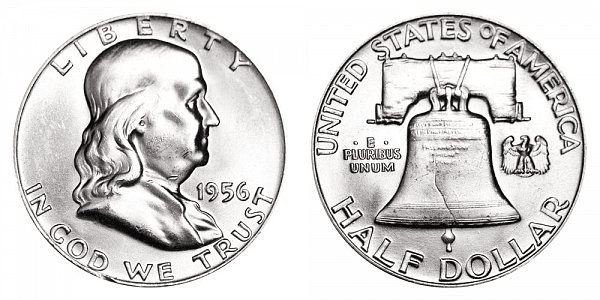
When it comes to design, the obverse (head) of the coin features the image of Benjamin Franklin. Inscriptions include LIBERTY, 1956, and IN GOD WE TRUST.
On the reverse (tail) of the coin, you will find the Liberty Bell with a small eagle on its right side. Inscriptions include UNITED STATES OF AMERICA, HALF DOLLAR, and E PLURIBUS UNUM.
The Franklin half dollar replaced the Walking Liberty half dollar. According to the law, a coin design should last for at least 25 years. The Walking Liberty half dollar was first issued in 1916. Thus, after 1940, it can already be replaced.
Ross already planned to start minting the Franklin 50-cent in 1941, but due to World War II, the plan was delayed and finally, it was struck in 1948.
Congress moved to change the half-dollar coin’s design to Kennedy design in 1963. The shocking death of the beloved Kennedy moved the country to honor him by adding his image to the 50-cent.
1956 Franklin Half Dollar Varieties
In 1956, the Philadelphia Mint was the only one that produced half-dollar coins. San Francisco was closed in 1955 and the Denver Mint chose not to produce 50-cent coins anymore due to low demand.
There are only two varieties of the half dollar coins and both come from the Philadelphia MInt. Here’s a table to help you see the varieties and their mintage:
| Variety | Mint Location | Mintage |
| 1952 P Franklin Half Dollar | Philadelphia | 4,032,000 |
| 1952 Proof Franklin Half Dollar | Philadelphia | 669,384 |
| Total | 4,701,384 |
Here’s a deeper look at the 1956 Franklin half dollar varieties:
1956 P Franklin Half Dollar
Year of minting: 1956
Mint Mark: none
Place of minting: Philadelphia
Quantity produced: 4,032,000
Face Value: $0.50 (ten cents)
Price: $9 to $11.50 (circulated condition)
Mass: 12.5 grams
Edge: Reeded
Designer: John R. Sinnock
Composition: 90% Silver and 10% Copper
Diameter: 30.6 millimeters
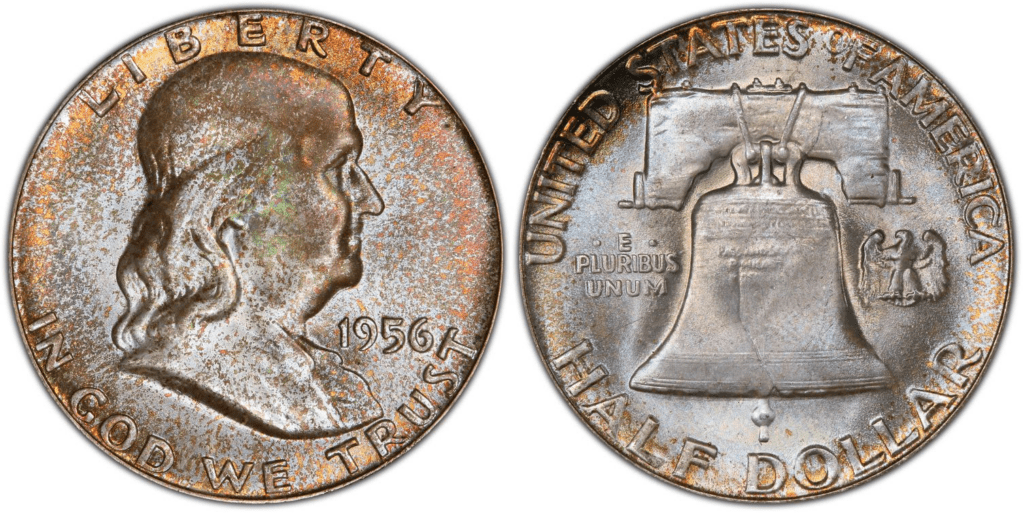
The Philadelphia Mint produced more than 4 million half-dollar coins. This is higher than what was produced in 1955, which has only seen about 2.5 million half-dollar coins. The following year, in 1957, the Philadelphia Mint produced more than 5 million.
From 1955 to 1957, the 50-cent coin was only produced in the Philadelphia Mint. Pricing can start at between $9 and $11.50. Some can be more expensive if it is sold in the open market.
1956 Proof Franklin Half Dollar
Year of minting: 1956
Mint Mark: none
Place of minting: Philadelphia
Quantity produced: 669,384
Face Value: $0.50 (ten cents)
Price: $75 or more (uncirculated condition)
Mass: 12.5 grams
Edge: Reeded
Designer: John R. Sinnock
Composition: 90% Silver and 10% Copper
Diameter: 30.6 millimeters
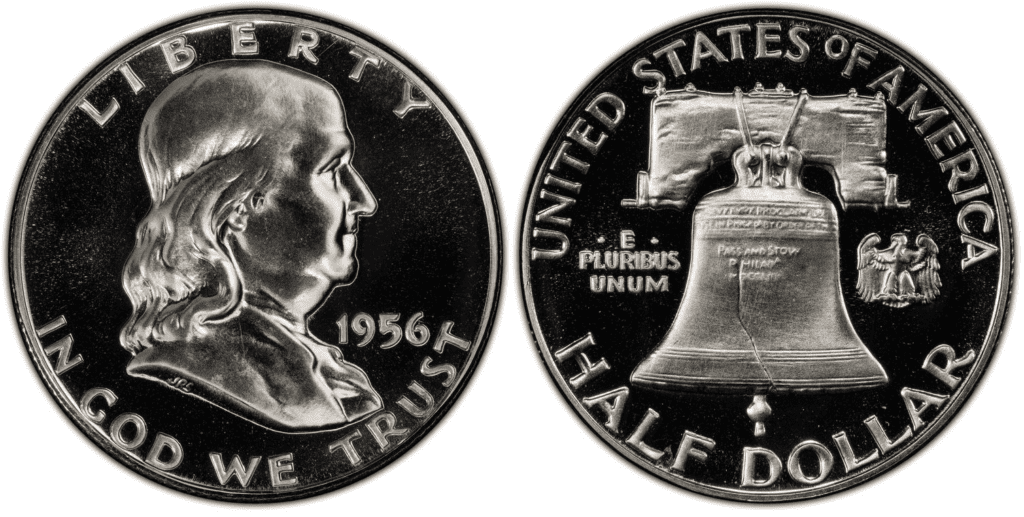
There’s a continued demand for proof coins but it is not as high as it should be compared to other years of minting. In 1956, only 669,384 proof coins were issued.
What’s interesting about the 1956 Franklin half dollar is that there were two versions of the reverse side of the coin. These are the type 1 and type 2 reverse.
Here’s a photo to show you the difference:
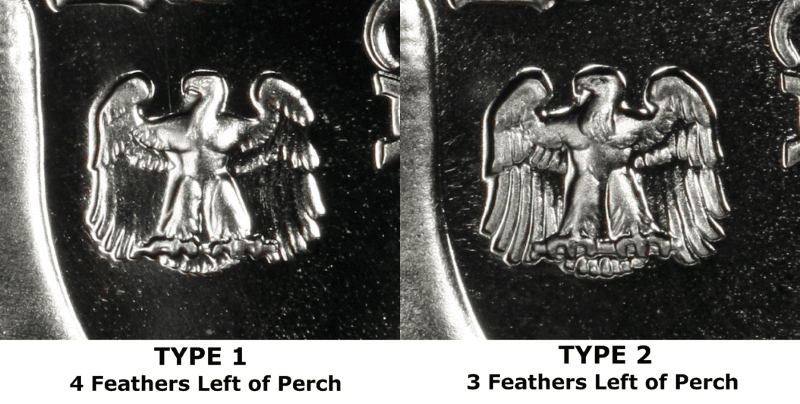
The big difference between the two types is the number of feathers. In type 1, you’ll find four feathers on the left of the perch. On the other hand, there are only 3 feathers on the left of the perch.
If you go back to the regular 1956-P 50-cent, you’ll find that the type 1 reverse was used. The proof coins received the two types of design. However, between the two types, proof coins with the type 2 design are more common.
The 1956 Franklin proof half dollar can be a little more expensive than the other proof coins in the series simply because there were only a few examples issued. Price may start at around $75.
List Of 1956 Franklin Half Dollar Errors
While there were just about 4.7 million half dollar coins issued in 1956, there were still some coins that received errors in their minting. Coin error primarily happens due to mechanical errors but it can also be due to human errors.
Here are some of the examples of 1956 Franklin half dollar errors:
Clipped planchet error
The clipped planchet error happens during the cutting of the blank coin. Because of a misalignment on the feeder, a current cut includes a portion of the previous cut, leading to the clipped planchet.
Here’s a good example of a 1956 Franklin half dollar with a clipped planchet:
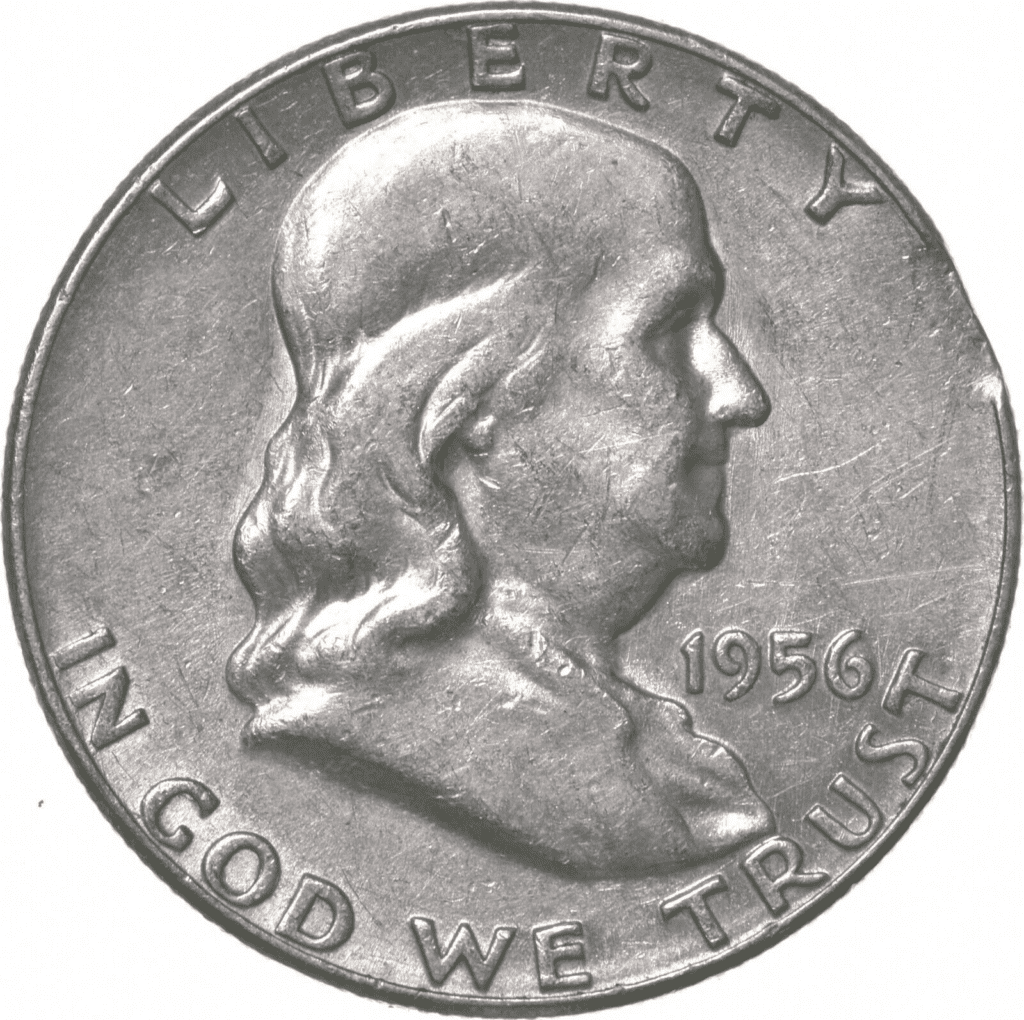
Doubled die error (goiter appearance)
When the die hits the blank coin twice, a doubled die error may potentially occur. If the second strike hits the blank coin at a different angle, you will see a doubling of some of the areas on the coin.
In 1956 Franklin half dollar, a doubled die error made Franklin’s neck look like it was bulging as if he had a goiter.
Here’s what it looks like:
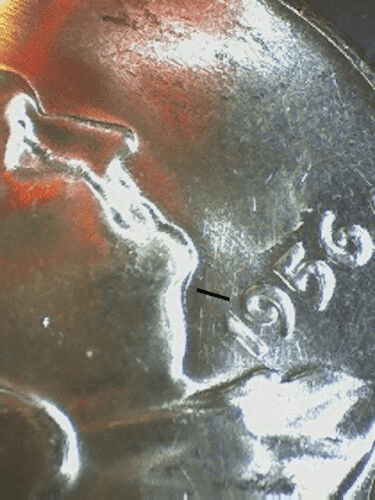
Clashed die error
The most common example of a clash die error is what they call the “Bugs Bunny Franklins.” During a clash die, the planchet is missing. That’s why, the two dies, the reverse and obverse, hit each other. The obverse die was damaged and this caused the lips of Franklin to look like it has buck teeth.
Here’s how it looks:
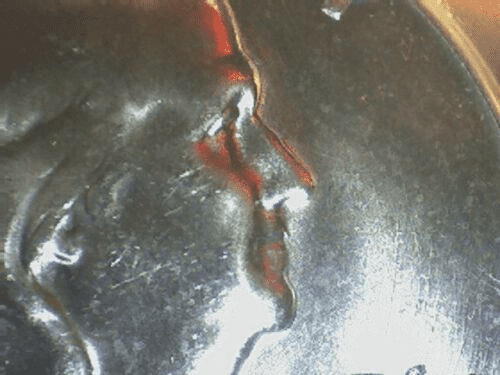
How Much Is 1956 Franklin Half Dollar Worth Today?
The 1956 Franklin half dollar is made of 90% silver. Thus, its melt value is higher than its face value, which is only 50 cents. The melt value for the 1956 Franklin half dollar is $7.9428.
According to Numismatic Guaranty Company (NGC), the regular price of the 1956 Franklin half dollar coin in circulated condition can start between $9 and $11.50.
To give you an idea of the price of 1956 half dollar coins, here’s a table to give you some of its top prices in the past years:
| Coin | Condition | Grade | Value |
| 1956 P Franklin Half Dollar | Superb Gem Uncirculated | MS 67 to MS 67+ | $216 to $1,410 |
| 1956 P Franklin Half Dollar | Gem Uncirculated | MS 65 to MS 66+ | $29 to $120 |
| 1956 Proof Franklin Half Dollar (Type 1) | Superb Gem Uncirculated | PR 68 (Deep Cameo) | $25,850 |
| 1956 Proof Franklin Half Dollar (Type 2) | Superb Gem Uncirculated | PR 69 (Deep Cameo) | $8,625 |
How Does The Grading System Work?
Grading a coin is done by professional coin grading service providers such as Professional Coin Grading Service (PCGS), Numismatic Guaranty Corporation (NGC), Independent Coin Graders (ICG), and ANACS.
Officially grading your coin can dramatically increase your coin’s value, especially if it receives a high grade. When grading, an appraiser would look at the preservation, strike, and appearance of the 1956 Franklin half dollar.
From there, they would use the Sheldon Scale and give your coin a numeric grade from 1 to 70. Adjectives are also used to describe the condition of a coin.
You will also notice that a 1956 Franklin half dollar would receive a designation of Full Bell Lines (FBL). It means that the coin has a good quality strike and you can find the horizontal lines on the Liberty Bell to be detailed.
Professional numismatists joined together in the 1970s and established CoinGrading standards. These numismatists now assign grades at key places on the seventy-point scale, using the most regularly utilized numeric points in conjunction with the original adjective grade. The following are the most common coin grades:
-
-
- (P-1) Poor – Indistinguishable and probably damaged; if used, must have a date and mintmark; otherwise, rather battered.
- (FR-2) Fair – Nearly smooth, but without the damage that a coin graded Poor often possesses. The coin must have enough detail to be identified.
- (G-4) Fair – Inscriptions have merged into the rims in some areas, and important elements have been mostly erased.
- (VG-8) Very Good- A little weathered, but all of the primary design elements are visible, albeit faintly. There is little if any, central detail left.
- (F-12) Good – The item is very worn, yet the wear is even, and the overall design details stand out clearly. Rims are almost completely isolated from the field.
- (VF-20) Very Fine – Moderately weathered, with some finer features still visible. The motto or all letters of LIBERTY are readable. Both sides of the coin have entire rims that are separated from the field.
- (EF-40) Extremely Fine – Gently used; all gadgets are visible, and the most important ones are bold. The finer details are bold and clear, however, light wear may be seen.
- (AU-50) Uncirculated – Slight evidence of wear on the coin’s design’s high points; may have contact marks; eye appeal should be adequate.
- (AU-58) Uncirculated Choice – Slight traces of wear, no severe contact marks, almost full mint shine, and great eye appeal.
- (MS-60) Mint State Basal – Strictly uncirculated; no indication of wear on the coin’s highest points, but an unsightly coin with reduced luster, visible contact marks, hairlines, and other flaws.
- (MS-63) Mint State Acceptable – Uncirculated, but with contact scratches and nicks, little reduced shine, but otherwise appealing appearance. The strike is weak to average.
- (MS-65) Mint State Choice – Uncirculated with great mint shine, very little contact blemishes, and exceptional eye appeal. The strike is unusually severe.
- (MS-68) Mint State Premium Quality – Uncirculated with superb luster, no obvious contact marks to the naked eye, and exceptional eye appeal. The strike is quick and appealing.
- (MS-69) Almost Perfect Mint State – Uncirculated with perfect brilliance, a sharp and appealing strike, and extremely good eye appeal. A near-perfect coin with minor imperfections in the planchet, strike, and contact markings (seen only under 8x magnification).
- (MS-70) Mint State Perfect – Under 8x magnification, there are no tiny imperfections discernible; the strike is crisp, and the coin is perfectly centered on a beautiful planchet. Rarely seen on a coin, this coin is bright and whole, with original luster and exceptional eye appeal.
-
Where To Buy Or Sell 1956 Franklin Half Dollar?
The 1956 Franklin half dollar is available online and offline. You can buy it on Amazon, Etsy, and especially, eBay. What’s great about buying online is that you can quickly get a list of options with just a few pushes of a button.
You can also try coin shops. These shops specialize in both buying and selling old coins. So, you might as well find a 1956 Franklin half dollar there. Auction houses could also be a good place to check since they are known to sell some of the rarest coins.
FAQs
Is a 1956 half dollar silver?
Yes, the 1956 half dollar is made of silver. It has 90% silver and 10% copper.
What is the difference between a 1956 Franklin half dollar type 1 and type 2?
The type 1 half dollar has 4 feathers on the left wing of the eagle. While the type 2 half dollar only has 3 feathers on the same side.
How much is a 1956 Franklin Half Dollar worth?
The 1956 Franklin half dollar can be bought for $8 to $12 in circulated condition. However, it can be bought for up to $900 or more in the open market. Some can even be more expensive. For example, a 1956 proof Franklin half dollar was sold for $25,850 on August 2, 2017. It has a PR-68 grade and a Deep Cameo designation.
